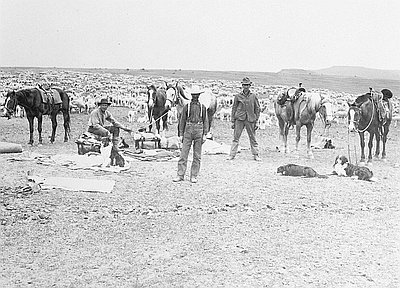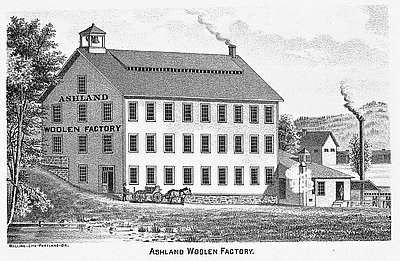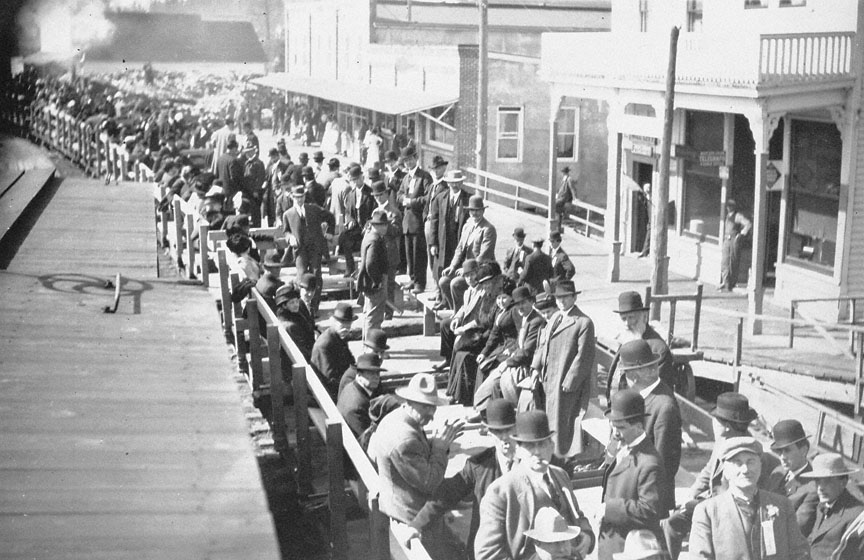- Catalog No. —
- OrHi 21067
- Date —
- c. 1910
- Era —
- 1881-1920 (Industrialization and Progressive Reform)
- Themes —
- Agriculture and Ranching, Environment and Natural Resources, Trade, Business, Industry, and the Economy
- Credits —
- Oregon Historical Society
- Regions —
- Central Northwest
- Author —
- Unknown
Wool Buyers at Shaniko
This photograph features wool buyers at Shaniko in eastern Wasco County. In 1910, the approximate date of this photograph, Shaniko was a major transportation hub linking central and Eastern Oregon to larger markets throughout the United States.
The name “Shaniko” derives from the surname of August Schernecknau, a German emigrant. In 1874, Schernacknau and his family settled near Cross Hollows, a stop on the stagecoach line linking The Dalles to Canyon City. Schernacknau and his family eventually left Cross Hollows after ten years of managing the local stage stop. However, when a group of local businessmen and farmers began developing plans for a new town site that would be located on the proposed Columbia Southern rail line into central Oregon, they decided that the name of the new town should be “Shaniko,” a common pronunciation of the name Schernacknau. These town promoters located the new settlement on the hill above Cross Hollows. The first train arrived in Shaniko in May 1900.
Within a year, two financiers from The Dalles, B.F. Laughlin and W. Lord, constructed a huge wool warehouse in Shaniko, the largest in Oregon at the time. Shaniko quickly became a major trade center for the wool produced in central and eastern Oregon. In 1903 Shaniko was referred to as the “Wool Capital of the World” after three wool sales brought in the largest total sale of wool on record to date. The next year, sheepmen sold an estimated five million dollars worth of wool to buyers in Shaniko. During this first decade of the twentieth century, Shaniko’s future seemed assured. However, in 1911 the town’s fortunes changed dramatically. That year, the Oregon Trunk Railroad, which ran along the Deschutes Canyon, was completed. The new line linking Bend and Madras to the Columbia Gorge soon began to draw business away from the more isolated Shaniko. In addition, a fire destroyed much of the downtown business district and there were no funds to reconstruct the damaged buildings. Although homesteaders, ranchers, and sheepmen continued to reside in the area, Shaniko never regained its former prominence.
Further Reading:
Rees, Helen Guyton. Shaniko: From Wool Capital to Ghost Town. Portland, Oreg., 1982.
Lomax, Alfred. “Oregon Wool-Scouring Plants of the Early 1900s.” Oregon Historical Quarterly 51, 1950: 43-52.
McGregor, Alexander Campbell. Counting Sheep: From Open Range to Agribusiness on the Columbia Plateau. Seattle, Wash., 1982.
Written by Melinda Jette, © Oregon Historical Society, 2004.
Related Historical Records
-
Central Oregon Sheepherders
This photograph depicts a group of sheepherders in Central Oregon during the latter decades of the nineteenth century. In the years following the Civil War, large, open tracts …

-
Ashland Woolen Mills
This 1884 illustration shows the Ashland Woolen Mills. The first such enterprise in Oregon was the Willamette Woolen Manufacturing Company, which began doing business in Salem in 1857. …

